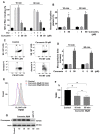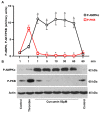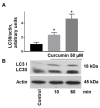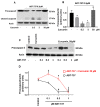Curcumin at Low Doses Potentiates and at High Doses Inhibits ABT-737-Induced Platelet Apoptosis
- PMID: 34065600
- PMCID: PMC8161296
- DOI: 10.3390/ijms22105405
Curcumin at Low Doses Potentiates and at High Doses Inhibits ABT-737-Induced Platelet Apoptosis
Abstract
Curcumin is a natural bioactive component derived from the turmeric plant Curcuma longa, which exhibits a range of beneficial activities on human cells. Previously, an inhibitory effect of curcumin on platelets was demonstrated. However, it is unknown whether this inhibitory effect is due to platelet apoptosis or procoagulant platelet formation. In this study, curcumin did not activate caspase 3-dependent apoptosis of human platelets, but rather induced the formation of procoagulant platelets. Interestingly, curcumin at low concentration (5 µM) potentiated, and at high concentration (50 µM) inhibited ABT-737-induced platelet apoptosis, which was accompanied by inhibition of ABT-737-mediated thrombin generation. Platelet viability was not affected by curcumin at low concentration and was reduced by 17% at high concentration. Furthermore, curcumin-induced autophagy in human platelets via increased translocation of LC3I to LC3II, which was associated with activation of adenosine monophosphate (AMP) kinase and inhibition of protein kinase B activity. Because curcumin inhibits P-glycoprotein (P-gp) in cancer cells and contributes to overcoming multidrug resistance, we showed that curcumin similarly inhibited platelet P-gp activity. Our results revealed that the platelet inhibitory effect of curcumin is mediated by complex processes, including procoagulant platelet formation. Thus, curcumin may protect against or enhance caspase-dependent apoptosis in platelets under certain conditions.
Keywords: apoptosis; autophagy; platelets; procoagulant activity; thrombin.
Conflict of interest statement
The authors declare no competing interests.
Figures







Similar articles
-
Regulatory Effects of Curcumin on Platelets: An Update and Future Directions.Biomedicines. 2022 Dec 8;10(12):3180. doi: 10.3390/biomedicines10123180. Biomedicines. 2022. PMID: 36551934 Free PMC article. Review.
-
Curcumin by activation of adenosine A2A receptor stimulates protein kinase a and potentiates inhibitory effect of cangrelor on platelets.Biochem Biophys Res Commun. 2022 Jan 1;586:20-26. doi: 10.1016/j.bbrc.2021.11.006. Epub 2021 Nov 4. Biochem Biophys Res Commun. 2022. PMID: 34823218
-
ABT-737 Triggers Caspase-Dependent Inhibition of Platelet Procoagulant Extracellular Vesicle Release during Apoptosis and Secondary Necrosis In Vitro.Thromb Haemost. 2019 Oct;119(10):1665-1674. doi: 10.1055/s-0039-1693694. Epub 2019 Sep 7. Thromb Haemost. 2019. PMID: 31493778 Free PMC article.
-
BCL2/BCL-X(L) inhibition induces apoptosis, disrupts cellular calcium homeostasis, and prevents platelet activation.Blood. 2011 Jun 30;117(26):7145-54. doi: 10.1182/blood-2011-03-344812. Epub 2011 May 11. Blood. 2011. PMID: 21562047
-
P2Y12 protects platelets from apoptosis via PI3k-dependent Bak/Bax inactivation.J Thromb Haemost. 2013 Jan;11(1):149-60. doi: 10.1111/jth.12063. J Thromb Haemost. 2013. PMID: 23140172
Cited by
-
Ameliorative anti-coagulant, anti-oxidative and anti-ferroptotic activities of nanocurcumin and donepezil on coagulation, oxidation and ferroptosis in Alzheimer's disease.Toxicol Res (Camb). 2024 Apr 10;13(2):tfae054. doi: 10.1093/toxres/tfae054. eCollection 2024 Apr. Toxicol Res (Camb). 2024. PMID: 38617712 Free PMC article.
-
Latest Innovations and Nanotechnologies with Curcumin as a Nature-Inspired Photosensitizer Applied in the Photodynamic Therapy of Cancer.Pharmaceutics. 2021 Sep 26;13(10):1562. doi: 10.3390/pharmaceutics13101562. Pharmaceutics. 2021. PMID: 34683855 Free PMC article. Review.
-
Regulatory Effects of Curcumin on Platelets: An Update and Future Directions.Biomedicines. 2022 Dec 8;10(12):3180. doi: 10.3390/biomedicines10123180. Biomedicines. 2022. PMID: 36551934 Free PMC article. Review.
References
MeSH terms
Substances
Grants and funding
LinkOut - more resources
Full Text Sources
Research Materials
Miscellaneous

